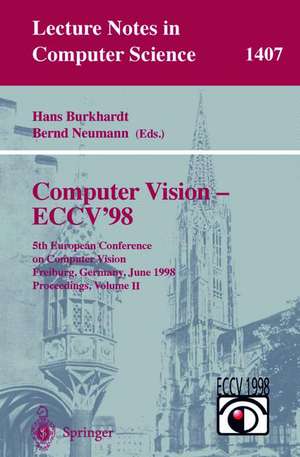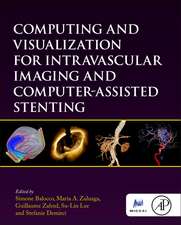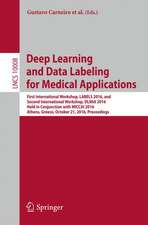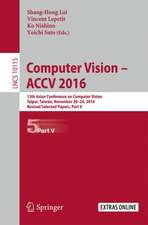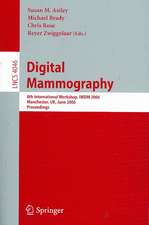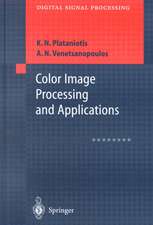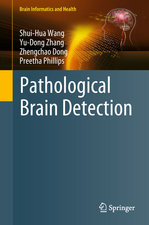Computer Vision - ECCV'98: 5th European Conference on Computer Vision, Freiburg, Germany, June 2-6, 1998, Proceedings, Volume II: Lecture Notes in Computer Science, cartea 1407
Editat de Hans Burkhardt, Bernd Neumannen Limba Engleză Paperback – 26 mai 1998
The 42 revised full papers and 70 revised posters presented were carefully selected from a total of 223 papers submitted. The papers are organized in sections on multiple-view geometry, stereo vision and calibration, geometry and invariances, structure from motion, colour and indexing, grouping and segmentation, tracking, condensation, matching and registration, image sequences and video, shape and shading, motion and flow, medical imaging, appearance and recognition, robotics and active vision, and motion segmentation.
| Toate formatele și edițiile | Preț | Express |
|---|---|---|
| Paperback (2) | 675.31 lei 6-8 săpt. | |
| Springer Berlin, Heidelberg – 26 mai 1998 | 675.31 lei 6-8 săpt. | |
| Springer Berlin, Heidelberg – 26 mai 1998 | 677.78 lei 6-8 săpt. |
Din seria Lecture Notes in Computer Science
- 20%
 Preț: 1061.55 lei
Preț: 1061.55 lei - 20%
 Preț: 307.71 lei
Preț: 307.71 lei - 20%
 Preț: 438.69 lei
Preț: 438.69 lei - 20%
 Preț: 579.30 lei
Preț: 579.30 lei -
 Preț: 410.88 lei
Preț: 410.88 lei - 17%
 Preț: 427.22 lei
Preț: 427.22 lei - 20%
 Preț: 596.46 lei
Preț: 596.46 lei - 15%
 Preț: 448.04 lei
Preț: 448.04 lei - 20%
 Preț: 353.50 lei
Preț: 353.50 lei -
 Preț: 389.49 lei
Preț: 389.49 lei - 20%
 Preț: 309.90 lei
Preț: 309.90 lei - 20%
 Preț: 645.28 lei
Preț: 645.28 lei - 20%
 Preț: 763.23 lei
Preț: 763.23 lei - 15%
 Preț: 580.46 lei
Preț: 580.46 lei - 20%
 Preț: 310.28 lei
Preț: 310.28 lei - 20%
 Preț: 655.02 lei
Preț: 655.02 lei - 20%
 Preț: 1183.14 lei
Preț: 1183.14 lei - 20%
 Preț: 340.32 lei
Preț: 340.32 lei -
 Preț: 449.57 lei
Preț: 449.57 lei - 20%
 Preț: 591.51 lei
Preț: 591.51 lei - 18%
 Preț: 938.83 lei
Preț: 938.83 lei - 20%
 Preț: 337.00 lei
Preț: 337.00 lei - 20%
 Preț: 649.50 lei
Preț: 649.50 lei - 20%
 Preț: 607.40 lei
Preț: 607.40 lei - 20%
 Preț: 1414.79 lei
Preț: 1414.79 lei - 20%
 Preț: 1024.44 lei
Preț: 1024.44 lei - 20%
 Preț: 583.40 lei
Preț: 583.40 lei - 20%
 Preț: 453.32 lei
Preț: 453.32 lei - 20%
 Preț: 575.49 lei
Preț: 575.49 lei - 20%
 Preț: 1075.26 lei
Preț: 1075.26 lei - 20%
 Preț: 585.88 lei
Preț: 585.88 lei - 20%
 Preț: 825.93 lei
Preț: 825.93 lei - 17%
 Preț: 360.20 lei
Preț: 360.20 lei - 20%
 Preț: 763.23 lei
Preț: 763.23 lei - 20%
 Preț: 340.32 lei
Preț: 340.32 lei - 20%
 Preț: 504.58 lei
Preț: 504.58 lei - 20%
 Preț: 369.13 lei
Preț: 369.13 lei - 20%
 Preț: 580.93 lei
Preț: 580.93 lei - 20%
 Preț: 343.62 lei
Preț: 343.62 lei - 20%
 Preț: 350.21 lei
Preț: 350.21 lei - 20%
 Preț: 583.40 lei
Preț: 583.40 lei - 20%
 Preț: 583.40 lei
Preț: 583.40 lei - 15%
 Preț: 438.59 lei
Preț: 438.59 lei - 20%
 Preț: 341.95 lei
Preț: 341.95 lei - 20%
 Preț: 238.01 lei
Preț: 238.01 lei - 20%
 Preț: 538.30 lei
Preț: 538.30 lei
Preț: 675.31 lei
Preț vechi: 844.14 lei
-20% Nou
Puncte Express: 1013
Preț estimativ în valută:
129.22€ • 138.18$ • 107.74£
129.22€ • 138.18$ • 107.74£
Carte tipărită la comandă
Livrare economică 18 aprilie-02 mai
Preluare comenzi: 021 569.72.76
Specificații
ISBN-13: 9783540646136
ISBN-10: 3540646132
Pagini: 884
Ilustrații: XXXII, 884 p.
Dimensiuni: 155 x 235 x 35 mm
Greutate: 1.24 kg
Ediția:1998
Editura: Springer Berlin, Heidelberg
Colecția Springer
Seria Lecture Notes in Computer Science
Locul publicării:Berlin, Heidelberg, Germany
ISBN-10: 3540646132
Pagini: 884
Ilustrații: XXXII, 884 p.
Dimensiuni: 155 x 235 x 35 mm
Greutate: 1.24 kg
Ediția:1998
Editura: Springer Berlin, Heidelberg
Colecția Springer
Seria Lecture Notes in Computer Science
Locul publicării:Berlin, Heidelberg, Germany
Public țintă
ResearchCuprins
Matching hierarchical structures using association graphs.- Stereo matching with implicit detection of occlusions.- A solution for the registration of multiple 3D point sets using unit quaternions.- Robust registration of dissimilar single and multimodal images.- Decoupling Fourier components of dynamic image sequences: A theory of signal separation, image segmentation, and optical flow estimation.- Spatiotemporally adaptive estimation and segmentation of OF-fields.- Robust video mosaicing through topology inference and local to global alignment.- Flexible syntactic matching of curves.- Holistic matching.- Creaseness from level set extrinsic curvature.- Multichannel shape from shading techniques for moving specular surfaces.- Modelling objects having quadric surfaces incorporating geometric constraints.- Surface reconstruction with multiresolution discontinuity analysis.- Shape from Chebyshev nets.- Changes in surface convexity and topology caused by distortions of stereoscopic visualspace.- Reconstruction of smooth surfaces with arbitrary topology adaptive splines.- (Mis?)-Using DRT for generation of natural language text from image sequences.- The structure of the optic flow field.- Optical flow using overlapped basis functions for solving global motion problems.- The role of total least squares in motion analysis.- Study of dynamical processes with tensor-based spatiotemporal image processing techniques.- Motion recovery from image sequences: Discrete viewpoint vs. differential viewpoint.- Discrete wavelet analysis: A new framework for fast optic flow computation.- Automatic detection and labelling of the human cortical folds in magnetic resonance data sets.- Efficient 3-D scene visualization by image extrapolation.- What shadows reveal about object structure.- Shape representations from shading primitives.- A comparison of measures for detecting natural shapes in cluttered backgrounds.- Bias-variance tradeoff for adaptive surface meshes.- Recognizing 3-D objects with linear support vector machines.- Active appearance models.- Estimating coloured 3D face models from single images: An example based approach.- A comparison of active shape model and scale decomposition based features for visual speech recognition.- Motion segmentation and depth ordering based on morphological segmentation.- Image sequence restoration: A PDE based coupled method for image restoration and motion segmentation.- Joint estimation-segmentation of optic flow.- Face recognition using active appearance models.- Face recognition using Evolutionary Pursuit.- Recognizing faces by weakly orthogonalizing against perturbations.- A probabilistic approach to object recognition using local photometry and global geometry.- Hypothesis verification in model-based object recognition with a gaussian error model.- Continuous audio-visual speech recognition.- Finding surface correspondence for object recognition and registration using pairwise geometric histograms.- Integrating iconic and structured matching.- Combining multiple views and temporal associations for 3-D object recognition.- Model-based recognition of 3D objects from one view.- A two-stage probabilistic approach for object recognition.- Combining geometric and probabilistic structure for active recognition of 3D objects.- Spatial dependence in the observation of visual contours.- Handling uncertainty in 3D object recognition using Bayesian networks.- Optimal robot self-localization and reliability evaluation.- Mobile robot localisation using active vision.- From reference frames to reference planes: Multi-view parallax geometry and applications.- Duality, rigidity and planar parallax.- On degeneracy of linear reconstruction from three views: Linear line complex and applications.
Caracteristici
Includes supplementary material: sn.pub/extras
